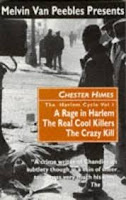Himes' last two novels, Blind Man With a Pistol and Plan B, are marked by a clear break as regards the role of the two detectives and the representation of Harlem. The existence of the two detectives was first determined by a narrative requirement. They only appear in the 8th chapter of A Rage in Harlem/For Love of Imabelle, when Himes realized what the presence of police could add to his intrigue. They are part of a larger whole: Harlem. Himes has built around Harlem a fiction necessary for the development of his detective stories. Harlem appears, in the early novels, in an imprecise way, as a free black state, with its own physical and human geography and borders. This is never explicitly said but rather suggested by remarkable omissions. Indeed, in Himes' description of Harlem, the marks of the Whites’ economic and political domination, and even, to a large extent, of their presence, are obscured.
The 1960s were marked in the United States by intense political struggles, with the civil rights movement, the emergence of more radical parties (Black Power), and the strong development of Black Muslims. Himes does not openly take sides but insists on the need for Blacks to use organized violence, not in a separatist or supremacist vision, but to create an irremediable shock. From All Shot Up (1960), and much more clearly from The Heat’s On (1961), several developments inexorably contribute to the explosion of the joint fiction of Harlem as a free city and of the two detectives as free policemen. The first one is a change in the nature of violence. In the first novels Harlem is violent but this violence occurs between Blacks (settling of scores, burglaries, scams, domestic violence). As soon as it appears, the violence of Whites turns out to be different: it emanates from organized crime (the heroin trade in The Heat’s On) and it comes from the South. It is therefore marked by sadism and inhumanity (All Shot Up, Cotton Comes to Harlem). As positive or endearing characters disappear, the Harlem cycle evolves towards drama.
Blind Man With a Pistol eventually reveals the domination of the Whites over Harlem. The interlude between the 2nd and 3d chapters puts an end to the deliberate omission of the previous seven novels. It focuses on the Mecca of Harlem, the intersection of 7th avenue and 125th street. “Many white people, riding the buses or in motorcars, pass this corner daily. Furthermore, most of the commercial enterprises – stores, bars, restaurants, theaters, etc. – and real estate are owned by white people. But it is the Mecca for black people. The air and the heat and the voices and the laughter, the atmosphere and the drama and the melodrama are theirs. Theirs are the hopes, the schemes, the prayers and the protest. They are the managers, the clerks, the cleaners, they drive the taxis and the buses, they are the clients, the customers, the audience; they work it, but the white man owns it.” The constant presence of Whites in Harlem was set up in Blind Man With a Pistol: the entire 1st chapter with the Mormon reverend, his 20 wives and 50 children, is seen through the eyes of two white policemen.
Blind Man With a Pistol highlights Harlem's absurdity: a hundred-year-old Mormon reverend, father of more than 50 children, a fertility treatment based on baboon testicles and fighting cock feathers, a television delivery in the middle of the night, a black plaster Jesus with fists clenched in rage… The city also falls prey to the agitation of movements which all betray black people, intentionally or because they are manipulated.
There is no longer any hope of deliverance and chaos has taken over Harlem. The two detectives run out of steam on a meaningless mission – to find the cause and the instigator of the riot –, and lose their authority, with the arrival of a white police hierarchy which distrusts them and pushes them aside. The first ending of Blind Man with a Pistol in the penultimate chapter shows the two inspectors slaughtering rats.
The three covers come from the Payback Press British edition (1996). It includes The Dilemma of the Black Writer in America, a conference given by Himes in 1948 (never before published) and introductions by Melvin Van Peebles and Lesley Himes.
The three covers come from the Payback Press British edition (1996). It includes The Dilemma of the Black Writer in America, a conference given by Himes in 1948 (never before published) and introductions by Melvin Van Peebles and Lesley Himes.



Aucun commentaire:
Enregistrer un commentaire
Ecrivez ici votre commentaire.